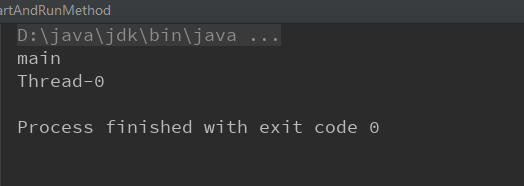启动线程的正确和错误方式:
- start()和run()的比较
- start()方法原理解读
- run()方法原理
start()和run()的比较
package threadcoreknowledge.startthread;
import threadcoreknowledge.createthreads.ThreadStyle;
/**
* 描述: 对比start和run两种启动线程的方式
*/
public class StartAndRunMethod {
public static void main(String[] args) {
Runnable runnable = () -> {
System.out.println(Thread.currentThread().getName());
};
runnable.run();
new Thread(runnable).start();
}
}
- start方法含义:
启动新线程:
不能重复start()
package threadcoreknowledge.startthread;
/**
* 描述: 演示不能两次调用start方法,否则会报错
*/
public class CantStartTwice {
public static void main(String[] args) {
Thread thread = new Thread();
thread.start();
thread.start();
}
}
如何正确停止线程?
原理:使用interrupt来通知,而不是强制
第一种情况:
package threadcoreknowledge.stopthreads;
/**
* 描述: run方法内没有sleep或wait方法时,停止线程
*/
public class RightWayStopThreadWithoutSleep implements Runnable {
@Override
public void run() {
int num = 0;
while (!Thread.currentThread().isInterrupted() && num <= Integer.MAX_VALUE / 2) {
if (num % 10000 == 0) {
System.out.println(num + "是10000的倍数");
}
num++;
}
System.out.println("任务运行结束了");
}
public static void main(String[] args) throws InterruptedException {
Thread thread = new Thread(new RightWayStopThreadWithoutSleep());
thread.start();
Thread.sleep(2000);
thread.interrupt();
}
}
第二种情况:
package threadcoreknowledge.stopthreads;
/**
* 描述: 带有sleep的中断线程的写法
*/
public class RightWayStopThreadWithSleep {
public static void main(String[] args) throws InterruptedException {
Runnable runnable = () -> {
int num = 0;
try {
while (num <= 300 && !Thread.currentThread().isInterrupted()) {
if (num % 100 == 0) {
System.out.println(num + "是100的倍数");
}
num++;
}
Thread.sleep(1000);
} catch (InterruptedException e) {
e.printStackTrace();
}
};
Thread thread = new Thread(runnable);
thread.start();
Thread.sleep(500);
thread.interrupt();
}
}
第三种情况:
package threadcoreknowledge.stopthreads;
/**
* 描述: 如果在执行过程中,每次循环都会调用sleep或wait等方法,那么不需要每次迭代都检查是否已中断
*/
public class RightWayStopThreadWithSleepEveryLoop {
public static void main(String[] args) throws InterruptedException {
Runnable runnable = () -> {
int num = 0;
try {
while (num <= 10000) {
if (num % 100 == 0) {
System.out.println(num + "是100的倍数");
}
num++;
Thread.sleep(10);
}
} catch (InterruptedException e) {
e.printStackTrace();
}
};
Thread thread = new Thread(runnable);
thread.start();
Thread.sleep(5000);
thread.interrupt();
}
}
while内try/catch的问题
package threadcoreknowledge.stopthreads;
/**
* 描述: 如果while里面放try/catch,会导致中断失效
*/
public class CantInterrupt {
public static void main(String[] args) throws InterruptedException {
Runnable runnable = () -> {
int num = 0;
while (num <= 10000 && !Thread.currentThread().isInterrupted()) {
if (num % 100 == 0) {
System.out.println(num + "是100的倍数");
}
num++;
try {
Thread.sleep(10);
} catch (InterruptedException e) {
e.printStackTrace();
}
}
};
Thread thread = new Thread(runnable);
thread.start();
Thread.sleep(5000);
thread.interrupt();
}
}
结果:
我们从上面的例子可以看到,即使我加了while的判断!Thread.currentThread().isInterrupted()来判断这个线程是否已被停止,但是程序依然没有停止!
解决方法:
第一种:
package threadcoreknowledge.stopthreads;
import threadcoreknowledge.createthreads.ThreadStyle;
/**
* 描述: 最佳实践:catch了InterruptedExcetion之后的优先选择:在方法签名中抛出异常 那么在run()就会强制try/catch
*/
public class RightWayStopThreadInProd implements Runnable {
@Override
public void run() {
while (true && !Thread.currentThread().isInterrupted()) {
System.out.println("go");
try {
throwInMethod();
} catch (InterruptedException e) {
Thread.currentThread().interrupt();
//保存日志、停止程序
System.out.println("保存日志");
e.printStackTrace();
}
}
}
private void throwInMethod() throws InterruptedException {
Thread.sleep(2000);
}
public static void main(String[] args) throws InterruptedException {
Thread thread = new Thread(new RightWayStopThreadInProd());
thread.start();
Thread.sleep(1000);
thread.interrupt();
}
}
第二种:
package threadcoreknowledge.stopthreads;
/**
* 描述:最佳实践2:在catch子语句中调用Thread.currentThread().interrupt()来恢复设置中断状态,以便于在后续的执行中,依然能够检查到刚才发生了中断
* 回到刚才RightWayStopThreadInProd补上中断,让它跳出
*/
public class RightWayStopThreadInProd2 implements Runnable {
@Override
public void run() {
while (true) {
if (Thread.currentThread().isInterrupted()) {
System.out.println("Interrupted,程序运行结束");
break;
}
reInterrupt();
}
}
private void reInterrupt() {
try {
Thread.sleep(2000);
} catch (InterruptedException e) {
Thread.currentThread().interrupt();
e.printStackTrace();
}
}
public static void main(String[] args) throws InterruptedException {
Thread thread = new Thread(new RightWayStopThreadInProd2());
thread.start();
Thread.sleep(1000);
thread.interrupt();
}
}
一、stop方法为什么不安全
其实stop方法天生就不安全,因为它在终止一个线程时会强制中断线程的执行,不管run方法是否执行完了,并且还会释放这个线程所持有的所有的锁对象。这一现象会被其它因为请求锁而阻塞的线程看到,使他们继续向下执行。这就会造成数据的不一致,我们还是拿银行转账作为例子,我们还是从A账户向B账户转账500元,我们之前讨论过,这一过程分为三步,第一步是从A账户中减去500元,假如到这时线程就被stop了,那么这个线程就会释放它所取得锁,然后其他的线程继续执行,这样A账户就莫名其妙的少了500元而B账户也没有收到钱。这就是stop方法的不安全性。
二、suspend方法为什么被弃用
suspend被弃用的原因是因为它会造成死锁。suspend方法和stop方法不一样,它不会破换对象和强制释放锁,相反它会一直保持对锁的占有,一直到其他的线程调用resume方法,它才能继续向下执行。
假如有A,B两个线程,A线程在获得某个锁之后被suspend阻塞,这时A不能继续执行,线程B在或者相同的锁之后才能调用resume方法将A唤醒,但是此时的锁被A占有,B不能继续执行,也就不能及时的唤醒A,此时A,B两个线程都不能继续向下执行而形成了死锁。这就是suspend被弃用的原因。
接下来是演示用volatile的局限:
package threadcoreknowledge.stopthreads.volatiledemo;
/**
* 描述: 演示用volatile的局限:part1 看似可行
*/
public class WrongWayVolatile implements Runnable {
private volatile boolean canceled = false;
@Override
public void run() {
int num = 0;
try {
while (num <= 100000 && !canceled) {
if (num % 100 == 0) {
System.out.println(num + "是100的倍数。");
}
num++;
Thread.sleep(1);
}
} catch (InterruptedException e) {
e.printStackTrace();
}
}
public static void main(String[] args) throws InterruptedException {
WrongWayVolatile r = new WrongWayVolatile();
Thread thread = new Thread(r);
thread.start();
Thread.sleep(5000);
r.canceled = true;
}
}
结果:
这种方法貌似是可行的,线程也被停止了。
但是在接下来这个例子里,这个方法就不可行了
package threadcoreknowledge.stopthreads.volatiledemo;
import java.util.concurrent.ArrayBlockingQueue;
import java.util.concurrent.BlockingQueue;
import java.util.concurrent.ConcurrentLinkedQueue;
/**
* 描述: 演示用volatile的局限part2 陷入阻塞时,volatile是无法线程的
* 此例中,生产者的生产速度很快,消费者消费速度慢,所以阻塞队列满了以后,生产者会阻塞,等待消费者进一步消费
*/
public class WrongWayVolatileCantStop {
public static void main(String[] args) throws InterruptedException {
ArrayBlockingQueue storage = new ArrayBlockingQueue(10);
Producer producer = new Producer(storage);
Thread producerThread = new Thread(producer);
producerThread.start();
Thread.sleep(1000);
Consumer consumer = new Consumer(storage);
while (consumer.needMoreNums()) {
System.out.println(consumer.storage.take()+"被消费了");
Thread.sleep(100);
}
System.out.println("消费者不需要更多数据了。");
//一旦消费不需要更多数据了,我们应该让生产者也停下来,但是实际情况
producer.canceled=true;
System.out.println(producer.canceled);
}
}
class Producer implements Runnable {
public volatile boolean canceled = false;
BlockingQueue storage;
public Producer(BlockingQueue storage) {
this.storage = storage;
}
@Override
public void run() {
int num = 0;
try {
while (num <= 100000 && !canceled) {
if (num % 100 == 0) {
storage.put(num);
System.out.println(num + "是100的倍数,被放到仓库中了。");
}
num++;
}
} catch (InterruptedException e) {
e.printStackTrace();
} finally {
System.out.println("生产者结束运行");
}
}
}
class Consumer {
BlockingQueue storage;
public Consumer(BlockingQueue storage) {
this.storage = storage;
}
public boolean needMoreNums() {
if (Math.random() > 0.95) {
return false;
}
return true;
}
}
结果:
通过上图可以很明显看出,这个线程并没有被停止,而是一直在运行中,无法被停止。下面我们就做一下改进:
package threadcoreknowledge.stopthreads.volatiledemo;
import java.util.concurrent.ArrayBlockingQueue;
import java.util.concurrent.BlockingQueue;
/**
* 描述: 用中断来修复刚才的无尽等待问题
*/
public class WrongWayVolatileFixed {
public static void main(String[] args) throws InterruptedException {
WrongWayVolatileFixed body = new WrongWayVolatileFixed();
ArrayBlockingQueue storage = new ArrayBlockingQueue(10);
Producer producer = body.new Producer(storage);
Thread producerThread = new Thread(producer);
producerThread.start();
Thread.sleep(1000);
Consumer consumer = body.new Consumer(storage);
while (consumer.needMoreNums()) {
System.out.println(consumer.storage.take() + "被消费了");
Thread.sleep(100);
}
System.out.println("消费者不需要更多数据了。");
producerThread.interrupt();
}
class Producer implements Runnable {
BlockingQueue storage;
public Producer(BlockingQueue storage) {
this.storage = storage;
}
@Override
public void run() {
int num = 0;
try {
while (num <= 100000 && !Thread.currentThread().isInterrupted()) {
if (num % 100 == 0) {
storage.put(num);
System.out.println(num + "是100的倍数,被放到仓库中了。");
}
num++;
}
} catch (InterruptedException e) {
e.printStackTrace();
} finally {
System.out.println("生产者结束运行");
}
}
}
class Consumer {
BlockingQueue storage;
public Consumer(BlockingQueue storage) {
this.storage = storage;
}
public boolean needMoreNums() {
if (Math.random() > 0.95) {
return false;
}
return true;
}
}
}
这里主要用到了interrupt来停止线程,跟之前的一样






























 1000
1000











 被折叠的 条评论
为什么被折叠?
被折叠的 条评论
为什么被折叠?








